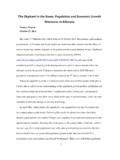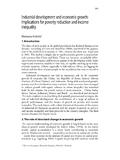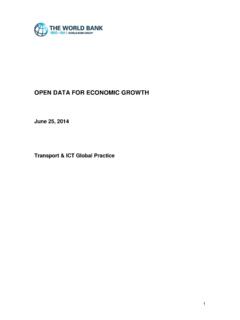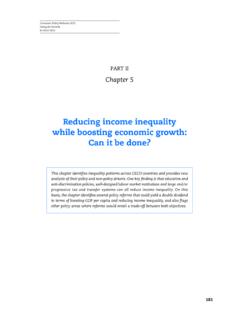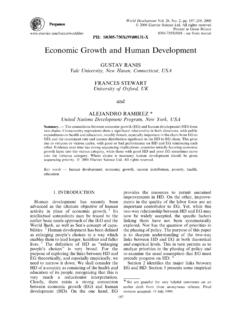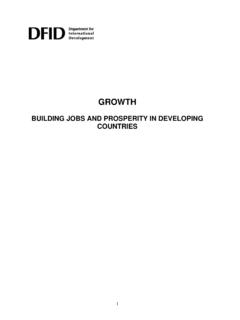Transcription of IS U.S. ECONOMIC GROWTH OVER? FALTERING …
1 NBER WORKING PAPER SERIES. IS ECONOMIC GROWTH OVER? FALTERING INNOVATION CONFRONTS. THE SIX HEADWINDS. Robert J. Gordon Working Paper 18315. NATIONAL BUREAU OF ECONOMIC RESEARCH. 1050 Massachusetts Avenue Cambridge, MA 02138. August 2012. This research has been supported by the Kauffman Foundation. Many facts and relationships highlighted here are based on my book in progress, Beyond the Rainbow: The American Standard of Living Since the Civil War, under contract to the Princeton University Press. To limit the scope of this short paper, only a limited number of historical references and citations are included here. All others are provided in the book manuscript. I am grateful to Marius Malkevicius and Andrew Sabene for their indispensable research assistance, and to David Warsh for helpful comments.
2 This paper originates in a presentation that has been given to numerous audiences over the past year, and I am grateful to members of those audiences for asking provocative questions and making helpful suggestions in the Q&A sessions. The views expressed herein are those of the author and do not necessarily reflect the views of the National Bureau of ECONOMIC Research. NBER working papers are circulated for discussion and comment purposes. They have not been peer- reviewed or been subject to the review by the NBER Board of Directors that accompanies official NBER publications. 2012 by Robert J. Gordon. All rights reserved. Short sections of text, not to exceed two paragraphs, may be quoted without explicit permission provided that full credit, including notice, is given to the source. Is ECONOMIC GROWTH Over?
3 FALTERING Innovation Confronts the Six Headwinds Robert J. Gordon NBER Working Paper No. 18315. August 2012. JEL No. D24,E2,E66,J11,J15,O3,O31,O4,Q43. ABSTRACT. This paper raises basic questions about the process of ECONOMIC GROWTH . It questions the assumption, nearly universal since Solow's seminal contributions of the 1950s, that ECONOMIC GROWTH is a continuous process that will persist forever. There was virtually no GROWTH before 1750, and thus there is no guarantee that GROWTH will continue indefinitely. Rather, the paper suggests that the rapid progress made over the past 250 years could well turn out to be a unique episode in human history. The paper is only about the United States and views the future from 2007 while pretending that the financial crisis did not happen. Its point of departure is GROWTH in per-capita real GDP in the frontier country since 1300, the until 1906 and the afterwards.
4 GROWTH in this frontier gradually accelerated after 1750, reached a peak in the middle of the 20th century, and has been slowing down since. The paper is about how much further could the frontier GROWTH rate decline? . The analysis links periods of slow and rapid GROWTH to the timing of the three industrial revolutions (IR's), that is, IR #1 (steam, railroads) from 1750 to 1830; IR #2 (electricity, internal combustion engine, running water, indoor toilets, communications, entertainment, chemicals, petroleum) from 1870 to 1900; and IR #3 (computers, the web, mobile phones) from 1960 to present. It provides evidence that IR #2 was more important than the others and was largely responsible for 80 years of relatively rapid productivity GROWTH between 1890 and 1972. Once the spin-off inventions from IR #2 (airplanes, air conditioning, interstate highways) had run their course, productivity GROWTH during 1972-96 was much slower than before.
5 In contrast, IR #3 created only a short-lived GROWTH revival between 1996. and 2004. Many of the original and spin-off inventions of IR #2 could happen only once urbanization, transportation speed, the freedom of females from the drudgery of carrying tons of water per year, and the role of central heating and air conditioning in achieving a year-round constant temperature. Even if innovation were to continue into the future at the rate of the two decades before 2007, the faces six headwinds that are in the process of dragging long-term GROWTH to half or less of the percent annual rate experienced between 1860 and 2007. These include demography, education, inequality, globalization, energy/environment, and the overhang of consumer and government debt. A provocative exercise in subtraction suggests that future GROWTH in consumption per capita for the bottom 99 percent of the income distribution could fall below percent per year for an extended period of decades.
6 Robert J. Gordon Department of Economics Northwestern University Evanston, IL 60208-2600. and NBER. 1. Introduction The prospects for future long-run ECONOMIC GROWTH were already dismal in 2007 but were little noticed in the continuing euphoria over the invention of the Internet and the related developments in information technology and communications (ICT). This article pulls back from the past five years of financial crisis to pose a question with implications that will persist for decades even if the current international ECONOMIC disorder is eventually resolved. This article is about ECONOMIC GROWTH through 2007 and the future post-2007 path of potential or trend output for the subsequent 20 to 50 years. The analysis abstracts almost entirely from the negative events that have occurred since 2007.
7 We deliberately ignore the separate questions of whether the recession and slow recovery have pulled down the trend GROWTH rate output, and the size of the gap between the trend path and actual real GDP. The ideas developed here are unorthodox yet worth pondering. They are applied only in the context of the United States, because the worldwide frontier of productivity and the standard of living have been carved out by the since the late 19th century. If GROWTH of the productivity frontier slows down, other nations may move ahead, or the slowing frontier could reduce the opportunities for future GROWTH by all nations as the pace of productivity GROWTH in the fades out. The article makes these basic points: 1. Since Solow's seminal work in the 1950s, ECONOMIC GROWTH has been regarded as a continuous process that will persist forever.
8 But there was virtually no ECONOMIC GROWTH before 1750, suggesting that the rapid progress made over the past 250 years could well be a unique episode in human history rather than a guarantee of endless future advance at the same rate. 2. The frontier established by the for output per capita, and the U. K. before it, gradually began to grow more rapidly after 1750, reached its fastest GROWTH rate in the middle of the 20th century, and has slowed down since. It is in the process of slowing down further. 3. A useful organizing principle to understand the pace of GROWTH since 1750 is the sequence of three industrial revolutions. The first (IR #1) with its main inventions between 1750. and 1830 created steam engines, cotton spinning, and railroads. The second (IR #2) was the most important, with its three central inventions of electricity, the internal combustion engine, and running water with indoor plumbing, in the relatively short interval of 1870 to 1900.
9 Both the first two revolutions required about 100 years for their full effects to percolate through the economy. During the two decades 1950-70 the benefits of the IR #2 were still transforming the economy, including air conditioning, home appliances, and the interstate highway system. After 1970 productivity GROWTH slowed markedly, most plausibly because the main ideas of IR. #2 had by and large been implemented by then. 1. 4. The computer and Internet revolution (IR #3) began around 1960 and reached its climax in the era of the late 1990s, but its main impact on productivity has withered away in the past eight years. Many of the inventions that replaced tedious and repetitive clerical labor by computers happened a long time ago, in the 1970s and 1980s. Invention since 2000 has centered on entertainment and communication devices that are smaller, smarter, and more capable, but do not fundamentally change labor productivity or the standard of living in the way that electric light, motor cars, or indoor plumbing changed it.
10 5. The article suggests that it is useful to think of the innovative process as a series of discrete inventions followed by incremental improvements which ultimately tap the full potential of the initial invention. For the first two industrial revolutions, the incremental follow-up process lasted at least 100 years. For the more recent IR #3, the follow-up process was much faster. Taking the inventions and their follow-up improvements together, many of these processes could happen only once. Notable examples are speed of travel, temperature of interior space, and urbanization itself. 6. The benefits of ongoing innovation on the standard of living will not stop and will continue, albeit at a slower pace than in the past. But future GROWTH will be held back from the potential fruits of innovation by six headwinds buffeting the economy, some of which are shared in common with other countries and others are uniquely American.










